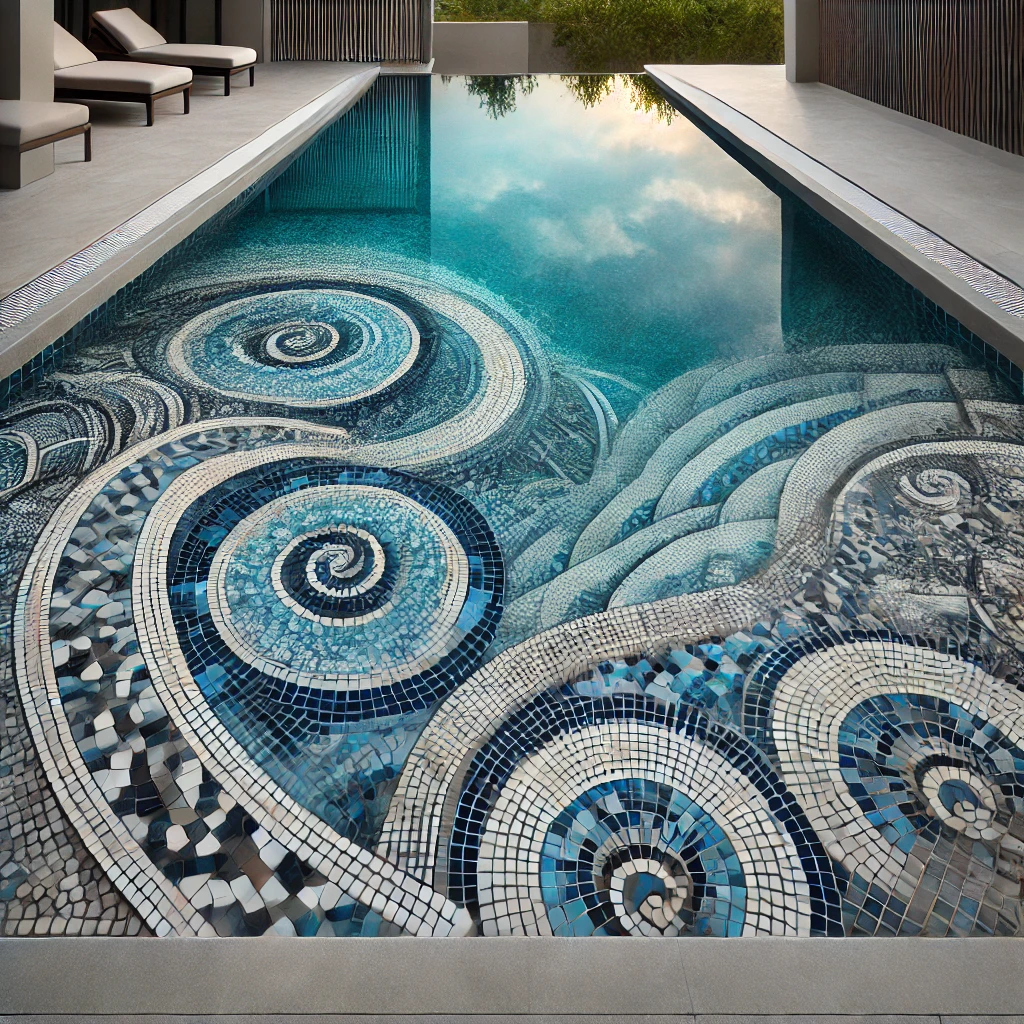1. Introduction
Mosaic tiles for swimming pools are more than just a functional material; they are crucial elements that enhance both the aesthetics and durability of the pool. Choosing the right mosaic tiles can significantly improve the visual appeal of your pool while also reducing maintenance costs over time. However, with the wide variety of materials, styles, and colors available on the market, making the best choice can be challenging. This article delves into the selection and maintenance strategies for swimming pool mosaics, helping you create a pool space that is both beautiful and practical.
2. Types of Pool Mosaic Tiles
2.1 Glass Mosaic Tiles
Glass mosaic tiles are renowned for their translucency and wide range of color options. Their smooth surface and stain-resistant properties make them a top choice for pool mosaics. Glass tiles are also waterproof, mold-resistant, and corrosion-resistant, making them ideal for both interior and exterior pool applications. Moreover, glass mosaics can enhance the visual effect of the pool by reflecting light, making the pool’s surface appear brighter and deeper.
2.2 Ceramic Mosaic Tiles
Ceramic mosaic tiles are widely used in pools due to their durability and ease of cleaning. These tiles offer a variety of surface textures, including matte, polished, and glazed finishes, adding unique tactile and visual appeal to the pool. Ceramic tiles are highly resistant to wear and weathering, making them capable of withstanding long-term exposure to sunlight, rain, and chemical cleaners.
2.3 Stone Mosaic Tiles
Stone mosaic tiles bring a natural aesthetic to the pool, often made from materials like marble, granite, or slate. Each stone tile has its unique pattern formed by nature, making it suitable for pool designs that emphasize a natural style. However, stone mosaics tend to be more expensive and require regular sealing to prevent water infiltration and stain accumulation.
3. How to Choose the Right Pool Mosaic Tiles
3.1 Functional Considerations
When choosing pool mosaic tiles, the first consideration should be their functionality. For example, in shallow areas and steps, opt for tiles with good slip resistance to ensure safety. Additionally, the tiles’ resistance to chemicals is crucial, as pool water typically contains chlorine and other chemicals.
3.2 Aesthetic Considerations
The choice of color and pattern should complement the overall pool design. Lighter-colored mosaics can make the pool appear larger and brighter, while darker mosaics can create a luxurious and deep visual effect. Additionally, consider mosaic patterns or gradient colors to add uniqueness and visual appeal to the pool.
3.3 Budget and Durability
Budget is an important factor when selecting mosaic tiles. While high-quality mosaics may come with a higher price tag, they often offer better durability and aesthetic appeal, reducing maintenance and replacement costs in the long run. Balancing initial investment with ongoing maintenance expenses is key to making a cost-effective choice.
4. Installation and Maintenance of Pool Mosaic Tiles
4.1 Installation Tips
Proper installation is the foundation for ensuring the longevity of mosaic tiles. First, the pool surface should be leveled to avoid uneven mosaic placement. Next, use high-quality adhesives and grout to ensure the mosaics do not detach in the long-term underwater environment. Additionally, pay special attention to waterproofing during installation to ensure the pool’s long-term integrity.
4.2 Routine Maintenance
Regular maintenance is essential to keep your pool mosaics looking beautiful and functioning well. Clean the mosaic surface with mild detergents and soft brushes, avoiding highly acidic or alkaline cleaners that could damage the tile surface. Regularly check the adhesion of the tiles, repairing any detached or damaged areas promptly to prevent further deterioration.
4.3 Seasonal Maintenance
During winter or extended periods of pool inactivity, it is recommended to conduct a thorough cleaning and sealing to protect the mosaics from the cold and damp environment. Before reopening the pool, perform a comprehensive inspection and cleaning to ensure the mosaics are in optimal condition.
5. Conclusion
Choosing the right pool mosaic tiles requires consideration of both aesthetics and functionality. By making the right choice and maintaining them properly, you can enhance the overall beauty of your pool while extending its lifespan and reducing long-term maintenance costs. Whether for private or public pools, high-quality mosaics are key to achieving this goal.



